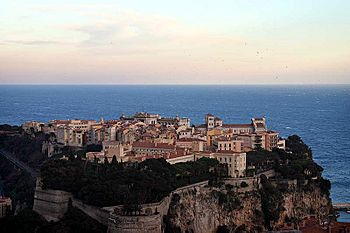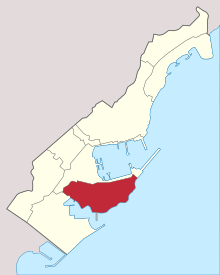Monaco-Ville facts for kids
Monaco City (French: Monaco-Ville) is the southcentral ward in the Principality of Monaco. Located on a headland that extends into the Mediterranean Sea, it is nicknamed The Rock (French: Le Rocher). The name "Monaco City" is misleading: it is not itself a city, but a historical and statistical district.
Contents
Geography
Monaco City is one of the four traditional quarters (French: quartiers) of Monaco; the others are La Condamine, Monte Carlo, and Fontvieille.
Monaco-Ville is located at 43°44′15″N 7°24′55″E / 43.73750°N 7.41528°E and has an estimated population of 975.
History
Monaco City was originally called in greek Monoikos, after the temple of Hercules Monoikos, located in a Phocaean colony of the 6th century BCE. During its history, Monoikos changed hands numerous times. It became Monaco in the Middle Ages. Some of the city walls and original structures still remain.
In 1297, the Rock was seized by François Grimaldi, a member of the House of Grimaldi. The Grimaldis made the old fortress their residence. The fortress evolved into the Palais Princier, which is the official residence of Albert II, Prince of Monaco.
Landmarks
Despite being located in the middle of the City of Monaco, the world's most densely populated urban center, Monaco City remains a medieval village at heart, made up almost entirely of quiet pedestrian streets and marked by virtual silence after sundown. Though innumerable people visit Monaco City and the palace square, only local vehicles are allowed up to the Rock, and gasoline-powered motorcycles are prohibited after 10 pm.
- Palais Princier, the Prince's palace. The colorful changing of the guard occurs every day outside the Palais at 11:55 am.
- Saint Nicholas Cathedral (French: Cathédrale de Monaco), a Romanesque-Byzantine church that contains the remains of many members of Monaco's ruling family.
- The Oceanographic Museum, established by Albert I, Prince of Monaco in 1910.
- Chapelle de la Misericorde, built in 1639, one of the oldest buildings in the principality. It is famous for being the starting point of a torchlit religious procession by local residents that takes place on the eve of Good Friday each year.
- St Martin Gardens, a small park of rocky paths that cling to the rock.
- Museum of the Chapel of Visitation, a 17th-century Roman Catholic chapel and art museum.
- Fort Antoine Theatre, an amphitheater at the bottom of the rock.
Images for kids
See also
 In Spanish: Mónaco-Ville para niños
In Spanish: Mónaco-Ville para niños







